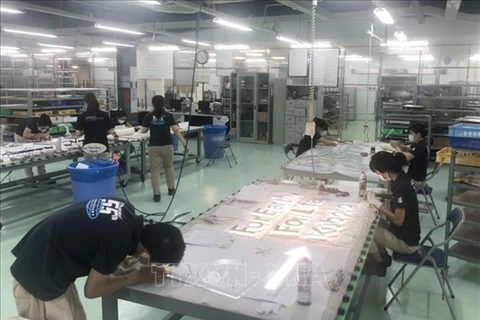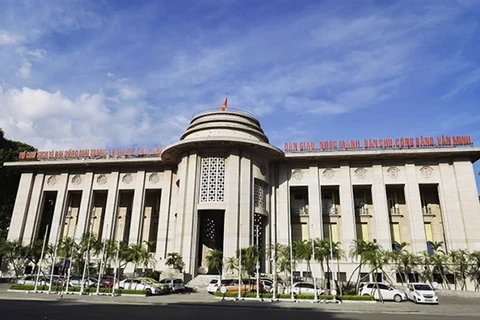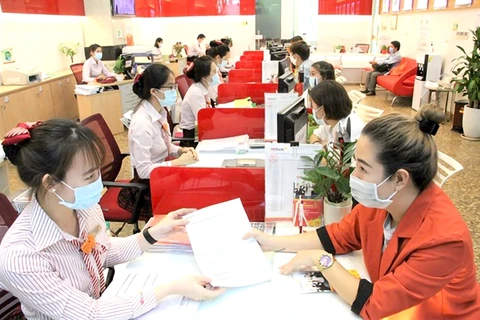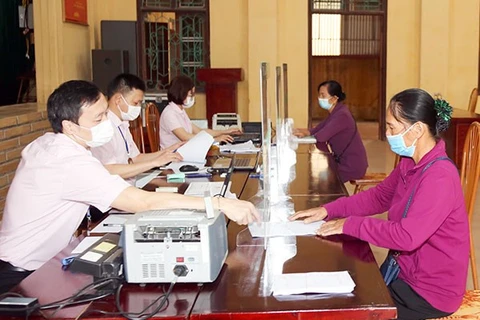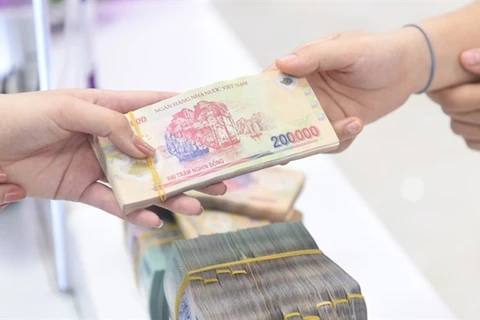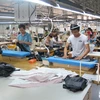Hanoi (VNS/VNA) - In the face of rising bad debt amid the ongoing COVID-19 pandemic, commercial banks have been forced to write up their loan loss provisions, according to industry sources.
Vietinbank was to increase its non-performing loan coverage ratio from 119 percent at the end of September to 169 percent for the rest of the year, with risk provisions from 14 trillion VND (617 million USD) to 17 trillion VND, said Vietinbank's Chairman of the Board Tran Minh Binh.
The move was a result of rising non-performing loans due to the pandemic and designed to improve the bank's buffer for the year to come.
"We have to stay vigilant and be prepared for 2022," he said.
VietinBank's credit risk provisions increased to 14 trillion VND by the end of September, a 22 percent, or 2.5 trillion VND, increase from the same period last year. The bank has set aside 5.5 trillion VND in provisions during the third quarter of 2021 as bad debt ratio reached 1.67 percent, the highest recorded in the last four quarters.
Vietcombank's provision cost has been reported to climb to over 8 trillion VND during the first nine months of the year, a 33 percent increase from the same period last year. During the third quarter alone, the bank raised its provision by 2.5 trillion VND, a 25 percent increase year-on-year.
Vietcombank reported its bad debt has doubled since the beginning of the year from 5.2 trillion VND to 10.8 trillion VND (from 0.62 percent to 1.16 percent) resulting in a lot of pressure to allocate even more funds to its provisions.
Meanwhile, BIDV has set aside 7.5 trillion VND during the third quarter, a 35 percent increase year-on-year, raising its provisions to over 23 trillion VND during the first nine months, a 44 percent increase year-on-year.
The bank had the highest bad debt ratio among commercial banks at 1.61 percent, a slight decrease from 1.76 percent at the beginning of the year.
The majority of commercial banks have all reported an increase in provision cost during the first three quarters of 2021: ACB 2.8 trillion VND, VPBank 13.6 trillion VND, LienVietPostBank 887 billion VND and TPBank 2.3 trillion VND.
Current regulations dictate banks must maintain provision rates at 0 percent for standard debt (Group 1), 5 percent for special attention required debt (Group 2), 20 percent for subprime loans (Group 3), 50 percent for doubtful debt (Group 4) and 100 percent for potentially irrecoverable debt (Group 5).
In addition, banks must also maintain 0.75 percent of total outstanding loans (excluding Group 5) in general provision.
However, the State Bank of Vietnam's (SBV) recent directives aimed at providing businesses with COVID-19 financial relief have forced banks to set aside a larger amount than usual in provisions.
"At this moment, I think that banks have built their own scenarios. Besides reducing interest rates to support people, the banks have also actively improved their financial capacity to ensure good operations in the future," said Nguyen Quoc Hung, General Secretary of the Vietnam Banking Association.
By the end of September, commercial banks have extended deadlines for over 270,000 customers with a total loan of over 330 trillion VND with interest cuts, per the SBV's request, of 12.2 trillion VND from July 15 to September 30./.
Vietinbank was to increase its non-performing loan coverage ratio from 119 percent at the end of September to 169 percent for the rest of the year, with risk provisions from 14 trillion VND (617 million USD) to 17 trillion VND, said Vietinbank's Chairman of the Board Tran Minh Binh.
The move was a result of rising non-performing loans due to the pandemic and designed to improve the bank's buffer for the year to come.
"We have to stay vigilant and be prepared for 2022," he said.
VietinBank's credit risk provisions increased to 14 trillion VND by the end of September, a 22 percent, or 2.5 trillion VND, increase from the same period last year. The bank has set aside 5.5 trillion VND in provisions during the third quarter of 2021 as bad debt ratio reached 1.67 percent, the highest recorded in the last four quarters.
Vietcombank's provision cost has been reported to climb to over 8 trillion VND during the first nine months of the year, a 33 percent increase from the same period last year. During the third quarter alone, the bank raised its provision by 2.5 trillion VND, a 25 percent increase year-on-year.
Vietcombank reported its bad debt has doubled since the beginning of the year from 5.2 trillion VND to 10.8 trillion VND (from 0.62 percent to 1.16 percent) resulting in a lot of pressure to allocate even more funds to its provisions.
Meanwhile, BIDV has set aside 7.5 trillion VND during the third quarter, a 35 percent increase year-on-year, raising its provisions to over 23 trillion VND during the first nine months, a 44 percent increase year-on-year.
The bank had the highest bad debt ratio among commercial banks at 1.61 percent, a slight decrease from 1.76 percent at the beginning of the year.
The majority of commercial banks have all reported an increase in provision cost during the first three quarters of 2021: ACB 2.8 trillion VND, VPBank 13.6 trillion VND, LienVietPostBank 887 billion VND and TPBank 2.3 trillion VND.
Current regulations dictate banks must maintain provision rates at 0 percent for standard debt (Group 1), 5 percent for special attention required debt (Group 2), 20 percent for subprime loans (Group 3), 50 percent for doubtful debt (Group 4) and 100 percent for potentially irrecoverable debt (Group 5).
In addition, banks must also maintain 0.75 percent of total outstanding loans (excluding Group 5) in general provision.
However, the State Bank of Vietnam's (SBV) recent directives aimed at providing businesses with COVID-19 financial relief have forced banks to set aside a larger amount than usual in provisions.
"At this moment, I think that banks have built their own scenarios. Besides reducing interest rates to support people, the banks have also actively improved their financial capacity to ensure good operations in the future," said Nguyen Quoc Hung, General Secretary of the Vietnam Banking Association.
By the end of September, commercial banks have extended deadlines for over 270,000 customers with a total loan of over 330 trillion VND with interest cuts, per the SBV's request, of 12.2 trillion VND from July 15 to September 30./.
VNA

